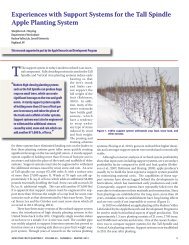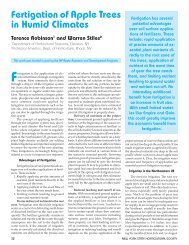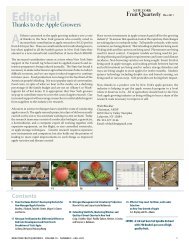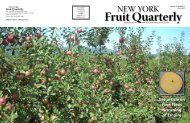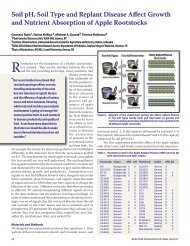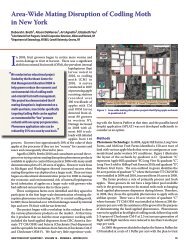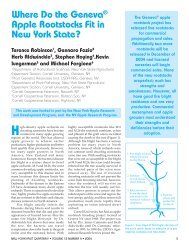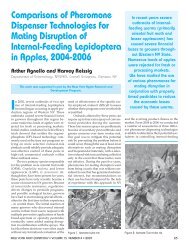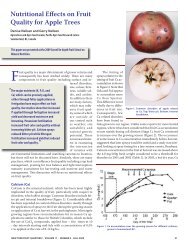The Apple Collection in Geneva, NY - New York State Horticultural ...
The Apple Collection in Geneva, NY - New York State Horticultural ...
The Apple Collection in Geneva, NY - New York State Horticultural ...
Create successful ePaper yourself
Turn your PDF publications into a flip-book with our unique Google optimized e-Paper software.
ity to latent virusesthan small-fruitedMalus species. Thiswould be especiallyuseful for breed<strong>in</strong>gfire blight-resistantrootstocks. GennaroFazio, directorof PGRU’s applerootstock breed<strong>in</strong>gproject, sees greatpotential—especiallywith crosses betweenKazak applesand elite Americanmaterial. This is thefuture of the apple<strong>in</strong>dustry <strong>in</strong> anotherfive to seven years.<strong>The</strong> naturalselection that occurs<strong>in</strong> the CentralAsian forests seemsto have helped theKazak trees developresistance to soilpathogens that canotherwise stuntHerb Aldw<strong>in</strong>ckle, plant pathologist from CornellUniversity, observes a susceptible seedl<strong>in</strong>g of M.sieversii <strong>in</strong>oculated with the bacterium (Erw<strong>in</strong>iaamylovora) that causes fire blight. (USDA/ARS)young apple orchards and lead to poor growth and lost production.This material is “a treasure trove” of new genetic variants forresistance to Phytophthora cactorum, which causes collar rot, andRhizoctonia solani, an agent of apple replant disease.<strong>The</strong> progeny of two of the Kazak trees have stood up particularlywell to disease. We put them through what we call “<strong>The</strong> Gauntlet,”which is exposure <strong>in</strong> the greenhouse to a series of pathogens that<strong>in</strong>clude fire blight and Phytophthora. It usually kills 70 to 80 percentof seedl<strong>in</strong>gs. However with this material we got 70 to 80 percent survivalrates. Test of this material by Mark Mazzola of ARS’s Tree FruitResearch Laboratory <strong>in</strong> Wenatchee, Wash<strong>in</strong>gton who specializes<strong>in</strong> soilborne diseases of apples, showed that it is significantly moreresistant to R. solani than the controls he was us<strong>in</strong>g. <strong>The</strong> reduction<strong>in</strong> root mass due to <strong>in</strong>fection was 30 percent, compared to 70 percentfor the controls. We are consider<strong>in</strong>g seek<strong>in</strong>g the <strong>in</strong>heritance of thisresistance by follow<strong>in</strong>g it—and the genes caus<strong>in</strong>g it—<strong>in</strong> the progeniesof these plants. This step will take us closer to clon<strong>in</strong>g and isolat<strong>in</strong>ggenes responsible for this resistance.<strong>The</strong>se seedl<strong>in</strong>gs have already become part of PGRU’s rootstockbreed<strong>in</strong>gprogram. With the aid of marker-assisted selection, theprogeny from these crosses will become the resistant rootstocks ofthe future. Also, root tissue from the survivors of the Phytophthora<strong>in</strong>oculation has been used to create a cDNA library that will besequenced as part of an ongo<strong>in</strong>g National Science Foundation ExpressedSequence Tag project. <strong>The</strong> goal is to f<strong>in</strong>d the genes that areexpressed only <strong>in</strong> resistant <strong>in</strong>dividuals.<strong>The</strong> Future<strong>The</strong> work to further characterize the collection cont<strong>in</strong>ues but<strong>in</strong>creased efforts to utilize the germplasm are underway. <strong>The</strong> goal nowis to release germplasm l<strong>in</strong>es from the collected materials with<strong>in</strong> fiveyears. <strong>The</strong>se collections are now be<strong>in</strong>g offered to breeders to developdiverse and useful hybrids for fruit, ornamental, and rootstock value.Today, it is becom<strong>in</strong>g clear that this collection may have an impact ondomestic apples production that will rival that of John Chapman’s.For while Chapman’s iconic work did much to spread apples acrossNorth America, recent f<strong>in</strong>d<strong>in</strong>gs <strong>in</strong> the wild apple germplasm fromCentral Asia—Kazakhstan <strong>in</strong> particular—have genetic resistance todiseases that may help apple breeders breed new varieties that do abetter job of defend<strong>in</strong>g themselves aga<strong>in</strong>st diseases. And the geneticmakeup of the trees may revolutionize the nation’s—and perhaps theworld’s—apple <strong>in</strong>dustry.AcknowledgementsA version of this article “Remarkable Kazak <strong>Apple</strong>s” was published<strong>in</strong> the January 2006 issue of Agricultural Research magaz<strong>in</strong>e.This research project is part of Plant, Microbial, and Insect GeneticResearch, Genomics, and Genetic Improvement, an ARS NationalProgram (#301) described on the World Wide Web at www.nps.ars.usda.gov.Philip Forsl<strong>in</strong>e is the curator of the National <strong>Apple</strong> <strong>Collection</strong> and is theresearch leader of the USDA-ARS Plant Genetic Resources Unit, on the campusof Cornell University’s <strong>New</strong> <strong>York</strong> <strong>State</strong> Agricultural Experiment Station located<strong>in</strong> <strong>Geneva</strong>, <strong>NY</strong>. Gennaro Fazio is research scientist with the USDA-ARS PlantGenetics Resources Unit located on the Experiment Station Campus. He leadsthe Cornell/USDA apple rootstock breed<strong>in</strong>g and evaluation program. Luis Ponsis a writer with the USDA-Agricultural Research Service Information Staff. HerbAldw<strong>in</strong>ckle is a research professor of plant pathology located at <strong>Geneva</strong>, <strong>NY</strong>, wholeads Cornell’s program on fire blight.8 NEW YORK STATE HORTICULTURAL SOCIETY



